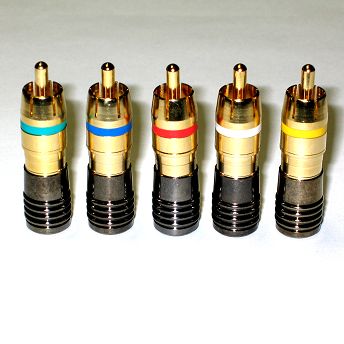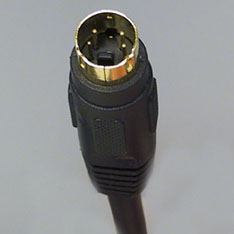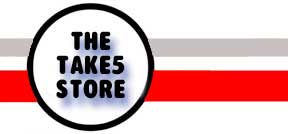How to Hook Up Your LCD Plasma DLP HDTV – HDMI? DVI? Component?
Congrats on entering the world of HD. Unlike the TV’s of yore (yore being 2003 of course), buying an HDTV and signing up for HD service does NOT assure you of actually receiving HD quality reception on your new TV.
YOU HAVE ONE MORE THING TO DO.
You need to make sure you are connected correctly to receive all the HD in its best glory on your TV set.
There are two main choices – HDMI & component. Both essentially offer you the greatest bandwidth in delivering HD quality from your set-top box into your TV.
Like our post on which technology to choose – LCD versus plasma versus DLP, this is meant as a general guide and a launching point for you to research more if you so choose.
YOUR CHOICES:
Which one to choose – much like the camp between plasma versus LCD versus DLP, there is no absolute clear cut choice … you would think there is for a freakin’ cable but no … unlike before – now we can’t even say one cable choice is better than another.
Let’s start with your cable box or satellite box. On the back of the HD ones are dozens of connectors. In the really old, old days, you had one choice – RF. In the near old days, you had composite out with better audio and lightly better video. Then in the old school days, you had S-video along with composite … now, you have USB, firewire, component, S-video, optical, DVI, HDMI … only problem, NOT every connector is active! So while they in theory, they offer you lots of choices, it might actually just be a theory so hook up everything you want – test it out to make sure you are actually getting a signal from that choice – BEFORE MOVING EVERYTHING INTO ITS FINAL PLACE.
So, from your cable/sat box out to the HDTV, your choices are …
HDMI

HDMI is simplistic in one sense – one cable carries both audio & video – and the plug only goes in one way from the TV set and/or the set top box. It looks a little like a giant firewire or a rounded USB plug and as such carries a digital signal. The argument for HDMI is that it is a digital “carrier system” so in theory, you are less likely to lose signal but that is not a 100% guarantee.
So, what’s the problem? Now, there is nothing wrong in theory with using HDMI but strangely enough, an HDMI cable’s signal is more likely to break down over time so if you choose HDMI, make sure you are able to re-access the area behind the wall to replace it if necessary (yes, it’s most likely un-necessary but just keep it mind if you are routing wiring behind the wall and re-patching) – but perhaps the biggest strike against it is that HDMI “can” carry a copy protection signal that can trigger a DO NOT COPY setting in set-top DVR’s (like some TiVo owners have found out). Now, right now, it has not been activated by anyone other than perhaps the NHL on a regular basis – it could be implemented in the future. I have a feeling most networks are afraid of doing so but just like their negotiating tactics with the Writer’s Guild right now, what do they care about consumers? – the lawyers & bean counters run entertainment now. So while you shouldn’t NOT hook it up via HDMI – you might also do an additional hookup via composite cables if your box allows to give you a backup choice. Now, some of the new HD boxes from your satellite company or cable company have a HDMI port but it is NOT ACTIVATED – so be sure and ask.
DVI

There was an intermediary DVI plug (even larger than HDMI) that was also a one connector cable that carries both audio and video but however looks more in place in the computer world. Since it did not carry the copy protection capababilty, it is being phased out by set-top manufacturers. Some cable/sat boxes offer a DVI output – most do not. However, most LCD sets (not plasma) will offer a DVI input which allows you to input a signal direct from your PC or Mac. This is a useful additional choice for LCD & DLP sets but not a major consideration for hooking up from your set top cable or sat box.
COMPONENT

These look like RCA type plugs but instead of VIDEO-LEFT AUDIO-RIGHT AUDIO, it’s component in the sense it breaks down your color bandwidth so one cable handles the entire range and unlike the old cable that handled RED, GREEN, BLUE, these also handle other aspects of your picture quality – again won’t bore you with the details but you should get a picture quality that matches HDMI or is very close – though of course, the signals are analog – and there is no copy protection included so if you have a choice, install both HDMI & component and judge for yourself which picture quality is better when it comes to the signal out from your set top box and since there’s no harm in filling your menu “input” choices, might as well connect both HDMI & Component if both work and you can decide later which one you prefer to watch TV with. The cable is a 5 headed connector with the connectors marked YPbPr and audio LEFT & audio RIGHT (usually white & red) while the video portion connectors are green-blue-red tipped or banded across the top.
S-VIDEO

One thing you will find is while HDMI or component make your HD signals and HD channels as clear as bell, they do muddy up the SD (or standard definition) channels – most people will still have anywhere from a few dozen to hundreds of channels still in SD and frankly, they will look smeared and low res compared to the HD channels. One way to get a slightly better picture is to watch SD channels via the S-video connector. S-video is a small round connector and you will notice the difference in video quality. Don’t forget to add audio cables as S-video does not carry an audio signal. Hopefully you have extra audio outs or you can try the optical audio out – again. Not certain if its activated on your box but worth the extra effort in getting a better video quality from your SD channels. This means you do have to change inputs when switching from HD to SD – some or most everyone will find this annoying but again, if you have to watch a lot of SD, it’s worth the cost of an S-video and either RCA audio or optical audio out connectors.
RF

I like connecting the RF out to the TV set as a test signal – if I’m getting reception/channels through RF, that means there’s nothing wrong with the incoming signal, either I have a loose connection somewhere or something is wrong with an output on the box to the TV. (RF is the old coaxial cable you’re familiar with).
Keep in mind the video quality will be quite low res so you’ll never really actually want to watch TV with this input choice but it’s just there as a test choice. If you get an RF signal to your TV, your cable box is working – the next problem to solve is whether it’s the cable from the box to your TV or your TV …
OTHER DEVICES?
Of course, most other devices like a DVD player/BluRay-HD player or game console should be sent out from that device via HDMI to your TV set. Depending on how often you plan on using the other devices and how many HDMI connectors you have on the back of your HDTV, you can either send signals through to other devices (receiver/DVD-recorder) or add a HDMI switcher.
And of course, remember, you need HD programming to get true HD. Details on our old post if you need a recap.
CABLE PRICING
HDMI cable pricing has dropped a great deal but most brand names will still run $30 to $95 dollars for 6 feet. You’ll still find some of the best pricing at the Apple store but of course, only you can judge whether you want to spend $4.50 or $29 or $95 for the same 6 feet.
Good luck!








Hi i am trying to hook up my Gateway p-series HDMI PC directly to my Magnavox HDTV by way of an HDMI cable to watch movies from Netflix. Both have HDMI portals. What is the procedure. I have windows Vista and a 1.3 version HDTV. I dont need to watch it on other tvs in my house or record or anyting else but watch the movies that i download from Netflix. Thank you Mike